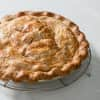How to Make the Best Whole-Wheat Pie Dough
Can you make pie crust that's just as flaky and tender using whole-wheat flour or rye flour? You bet.
Adding whole-wheat flour to pie dough is a catch-22. It adds an appealing nutty flavor but can prevent the crust from developing shatteringly crisp, flaky layers. That's because whole-wheat flour doesn't form as much structure-building gluten as all-purpose flour does, so crusts containing too much whole wheat often bake up overly delicate and crumbly. The usual solution is to add only a small amount of whole wheat to the dough. But what if there were a recipe that needed less than half the flour to form gluten, while the remainder didn't need to contribute to structure at all? Our recipe for Foolproof All-Butter Pie Dough does just that: Only 40 percent of the flour forms gluten, and the crust bakes up beautifully flaky and crisp. We wondered if the technique we employ in that recipe would allow us to load up a pie dough with as much as 60 percent whole wheat without compromising its texture.
Experiment
We made three batches of Foolproof All-Butter Pie Dough, processing 60 percent of the flour with most of the butter to form a paste and breaking the paste into chunks before adding the rest of the flour and butter and finally the water. For the first batch we used all-purpose flour in the paste as a control. In the second batch, we used whole-wheat flour in the paste, and in the third batch—to really challenge our premise—we used gluten-free flour. We used all-purpose flour for the remaining 40 percent of the flour in all three doughs. We rolled, shaped, and blind-baked each crust before tasting.
Results
All the crusts had plenty of shattery, crisp layers and were tender without being overly crumbly or fragile. These qualities were particularly remarkable in the 60 percent gluten-free crust, which had the potential to lack any structure at all.
Explanation
The butter “waterproofs” the first portion of flour, meaning that it's unable to form a gluten network once water is added. Only the second portion of flour can do that. When baked, the glutinous portion forms a crisp, flaky framework for the non-gluten-forming portion, which contributes the richness and tenderness we expect of pie crust.
Our novel method means you can create pie dough with 60 percent flavorful (but gluten-challenged) flour, such as whole-wheat, rye, or even buckwheat (which can't form gluten at all). The crusts will bake up with supercrisp, flaky layers, thanks to the gluten formed by the second portion of all-purpose flour.



